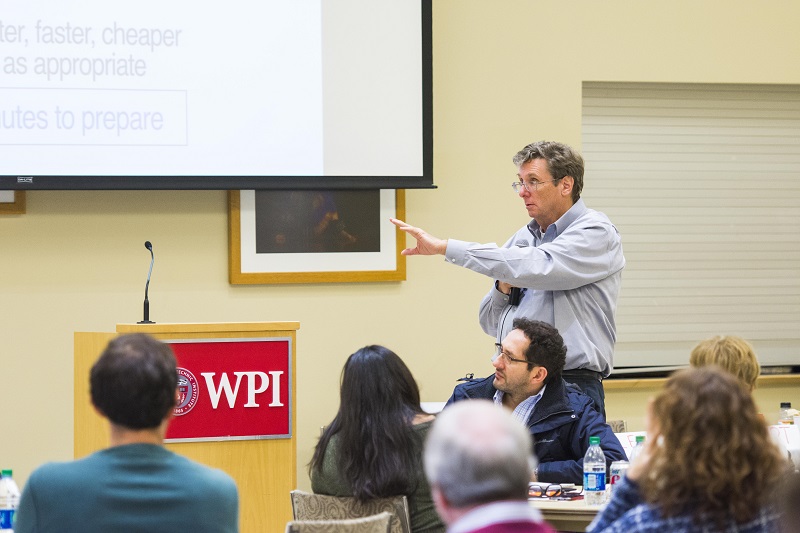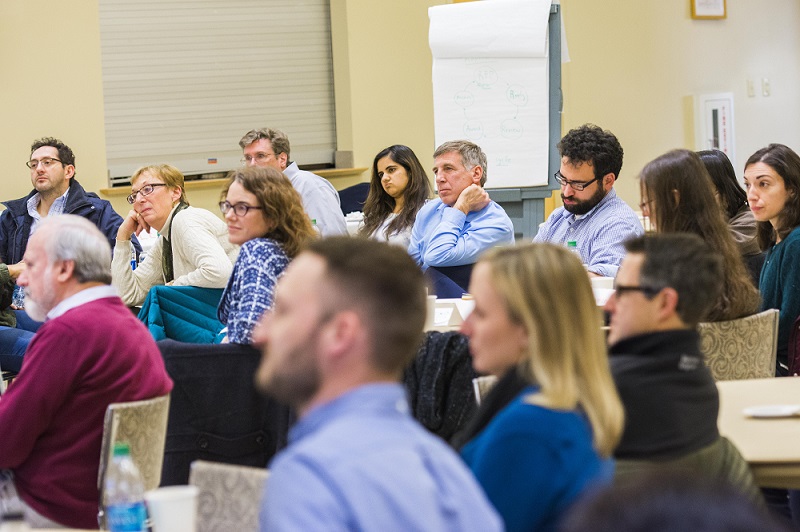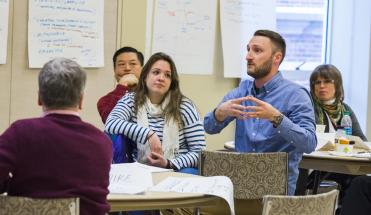Do you ever wonder why some innovative ideas land so successfully while other ideas that seemed perfectly on-target fail so spectacularly?
For the nearly 70 participants in the recent KEEN Value Creation Workshop, learning the difference between what makes one great idea change the world while another fizzles in a money-sucking loop came down to understanding that ideas and innovations are worthless unless they have value.

Curt Carlson addresses attendees of the KEEN Value
Creation Workshop.
Workshop leaders Curt Carlson ’67, WPI trustee, Hall of Luminaries inductee, and founder and CEO of Practice of Innovation, and Len Polizzotto ’70, sole proprietor of the business consulting company CIRA Associates LLC, say value creation is the missing tool in many professionals’ skill sets, but one that is essential for success. As partners in Practice of Innovation, they travel the world offering this workshop to executives and organizations and are especially pleased to offer it for a fourth time at their alma mater. The recent workshop was sponsored by a KEEN grant (of which Glenn Gaudette, professor of biomedical engineering, is the PI) from the Kern Family Foundation.
“For us, this is a really big deal,” says Carlson. “Value creation is not a nice-to-have. It is a must-have.” The logic behind value creation (that even the most spectacular idea is worthless if there is no need for it), and the big-picture process behind value creation fit exceptionally well with WPI’s approach and strategy. “The WPI Plan transformed WPI,” says Polizzotto. “What’s the next leap?” For Carlson and Polizzotto, value creation innovation amplifies the impact of WPI’s distinctive project work.
The one-day workshop agenda (Carlson and Polizzotto also offer a two-day version) asked attendees to come ready to tackle diverse, self-identified initiatives they wanted to advance through value creation. Teams initially drafted a value creation proposition for their initiative (projects, departments, and coursework that included angles from athletics to online education to STEM) and then gave a three-minute presentation to the group. That’s when the work really began. The group as a whole gave feedback for each value creation proposition, so teams were then tasked with revising, sharpening, and clarifying their proposition. With each iteration, teams become more focused and more aware of why their initial plan might not work.
“The idea is to get you better and better at what you are doing,” Polizzotto told the group. The action of having others offer new perspectives, different opinions, or novel ways of thinking on each iteration of a value creation proposition helps clarify its value as a product or process.
“If you are doing a project, you want to make sure it’s a project people care about. Solving a problem that people have—that’s what leads to innovation.” -Len Polizzotto
Janet Zafiris, grant operations administrator with the biomedical engineering department, says the workshop was fairly equally divided between faculty and staff attendees (with one group of students), but that results are far-reaching as they are often incorporated directly into classroom and project work. “It’s a way for teams to find out how to further the initiatives they want to work on,” she says.
The process isn’t always comfortable, and it takes plenty of practice. It does, however, give an end result that is more effective, more on target, and, yes, has more value. As teams narrow their proposition, they understand why their first idea is often not the one that gives the most value or that even has any value. This is often when breakthroughs happen.
“If you are doing a project, you want to make sure it’s a project people care about,” says Polizzotto, noting that people tend to want to solve a problem they have, not necessarily a problem their customers have. “Solving a problem that people have—that’s what leads to innovation.”
Struggling to distill value creation from an initial idea is common. “We see it over and over,” says Carlson. “We present this to PhDs from the best schools and they cannot do this.” It takes practice and understanding—and the payoff is great. “This is the best time for innovation ever, if you have these skills,” he says.

The workshop taught participants the importance of
value creation.
Jeannine Coburn, assistant professor of biomedical engineering, says her team from the BME department came to the workshop with the intent of identifying more opportunities for undergraduates and, therefore, creating more value for them. “Part of the innovative process is identifying opportunity,” she says. “Being innovative isn’t necessarily inventing. It’s like this—meeting a need.”
Coburn says the process of identifying an authentic need, getting feedback from the group, reiterating and narrowing down the intent are all essential to fostering a mindset that can create value and trigger innovation that has positive impact on students. Coburn’s team is exploring how to increase student opportunities for clinical interaction and independence while also positioning WPI’s standing as an innovative BME community partner.
Robotics engineering grad student Alka Choudhary ’19, says she was especially interested in learning how to take a project from the idea level to a pitch level and then how to present that to an audience. With a specific idea in mind, Choudhary says the workshop gave her a new perspective. “That 'need of customer' is an important part that I have never given so much importance,” she says. “It will help personally in all the fronts of life where you want to convince the other person in your thought.”
Carlson says offering this workshop at WPI is a way of giving back, but it’s also a way of ensuring WPI students remain on the cutting edge.
“We understand the value of this process and also the value of creation and innovation and how important these skills are for students today,” Carlson says. Familiarity with value creation as a student also helps long before commencement day. “They will do a much better job in their projects,” says Polizzotto, “and it will make their project work easier. They will learn to iterate and to work in a team.”
While many companies teach essentials like leadership and teamwork, scant few teach value creation because they aren’t familiar with it. After graduation, the big-picture approach that value creation requires makes students stand out.
“These skills will make them employees for life,” says Polizzotto. “These skills are good forever.”
- By Julia Quinn-Szcesuil



